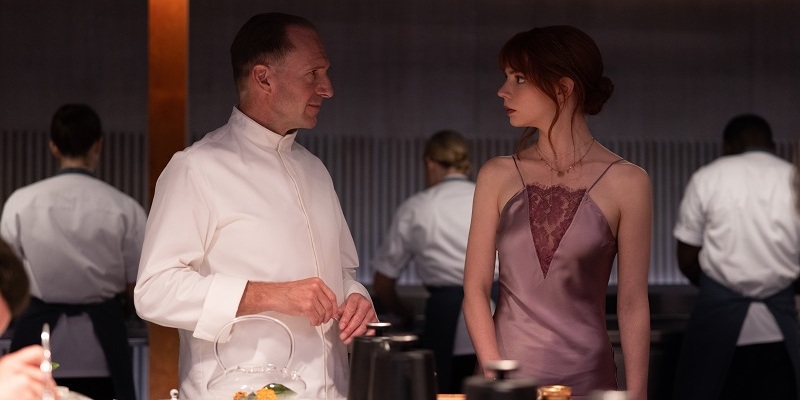
Review by
Eric Hillis
Directed by: Mark Mylod
Starring: Ralph Fiennes, Anya Taylor-Joy, Nicholas Hoult, Hong Chau, Janet McTeer,
Reed Birney, Judith Light, John Leguizamo

Several horror movies have taken their structural cues from
Willy Wonka and the Chocolate Factory. What are the likes of the
Saw
and
Escape Room
series but gory reworkings of Roald Dahl's template, with a group of
strangers punished for their sins in the trap-filled lair of a madman,
only for the most "innocent" among them to emerge from the experience
intact? Director Mark Mylod's The Menu is the most
blatant of the Wonkabes, sending its cast to the island lair of a madman
who specialises in culinary delights.

The Wonka surrogate is Julian Slowik (Ralph Fiennes), a renowned
chef who operates a restaurant on a remote island accessible only to
those with deep pockets. The Charlie figure is Margot (Anya Taylor-Joy), a working class girl who takes a trip to the island as a last-minute
substitute date for arrogant young foodie Tyler (Nicholas Hoult).
Margot stands out from Tyler and the other guests, who fawn over the
pretentious presentations of Slowik while she makes snide comments like
a Groucho Marx in a room filled with Margaret Dumonts.
Slowik likes to treat food as art, and presents it as modern art. It's
difficult to tell whether Slowik is taking the piss out of his guests or
the film is mocking the world of haute cuisine, or both. The courses
served border on the absurd, with diners presented with plates filled
mostly with stones and a bread plate minus the actual bread, because
bread is for poor people.

Midway through the menu (both the film and Slowik's menu), things take
a dark turn as it's revealed that Slowik has sinister intentions towards
his customers. Bloodshed ensues as the diners find themselves trapped on
the island. It's at this point the movie begins to double down on its
debt to horror movies of the early 1930s.
The Most Dangerous Game
is heavily referenced, via Margot's figure-hugging Fay Wray gown and a
sequence where the male diners are given a headstart to attempt an
escape from the island. Nodding to Tod Browning's
Freaks, Slowik asks Margot whether she believes she belongs with the diners
or the staff – "Are you one of us?" The modernist design of Slowik's
restaurant recalls Boris Karloff's home in Edgar G. Ulmer's
The Black Cat. You could easily imagine the Slowik role being played by Karloff,
Charles Laughton or Leslie Banks.
But had The Menu been made in 1933 it would have come in
at a tight 72 minutes. By that point The Menu has run out
of ideas, and there are still another 34 minutes to go. Mylod comes from
a comedy background, so it's no surprise that the movie is most
effective in its satirical opening chapters. Like the recent
Triangle of Sadness, the jokes at the expense of elites are cheap jabs, but they're
amusing nonetheless. At some point however the ribbing veers close to
"My six-year-old could make that" territory. Is our laughter at Slowik's
flamboyant presentations (at one point a wine is described as tasting of
"longing and regret") any different to the people who reply to film
reviews with "It's not that deep bro"? There is of course one big
difference, and that's the class dynamic. Film is accessible to everyone
regardless of their station in life, while haute cuisine isn't.
Ignorance of the joys of a $100,000 bottle of wine is out of our hands,
while it requires willful ignorance to dismiss "arty" films.

Like so many of today's mainstream American horror movies,
The Menu isn't happy to simply be a horror movie. It's a
movie with a "message." That's fine, lots of great horror movies are
made by people with something to say, but the current crop don’t
understand the notion of subtext, and resolutely dismiss the idea of
"show, don’t tell." Just in case we couldn't figure it out for
ourselves, the script of The Menu sees Slowik literally
explain the film's themes to the audience. That theme isn't exactly
novel, boiling down to a main course of "rich folks bad" with a digestif
of "men bad too." What makes things messy is that these ideas are
presented by the film's antagonist. The diners are an unlikable lot (and
if we're honest, much of our antipathy comes from our jealousy of their
elevated stations in life), but none of them have remotely transgressed
enough to be deserving of the fate Slowik has in store. Had the movie
stuck to the political cartoon style satire of its first half, its
mean-spirited second half might have been easier to swallow. But while
it's mean-spirited, The Menu never feels like it's made by someone with
a genuine hostility towards the targets of its rage, and let's face it,
the above-the-line creatives behind the movie have probably frequented
establishments like Slowik's more times than they would like to reveal.
'Charlie and the Chocolate Factory' suggests Roald Dahl had a genuine
disgust towards the entitled little shits Willy Wonka tortures, while
The Menu comes off as a comedy roast, a self-effacing but
entirely unscathing in-joke among elites.


